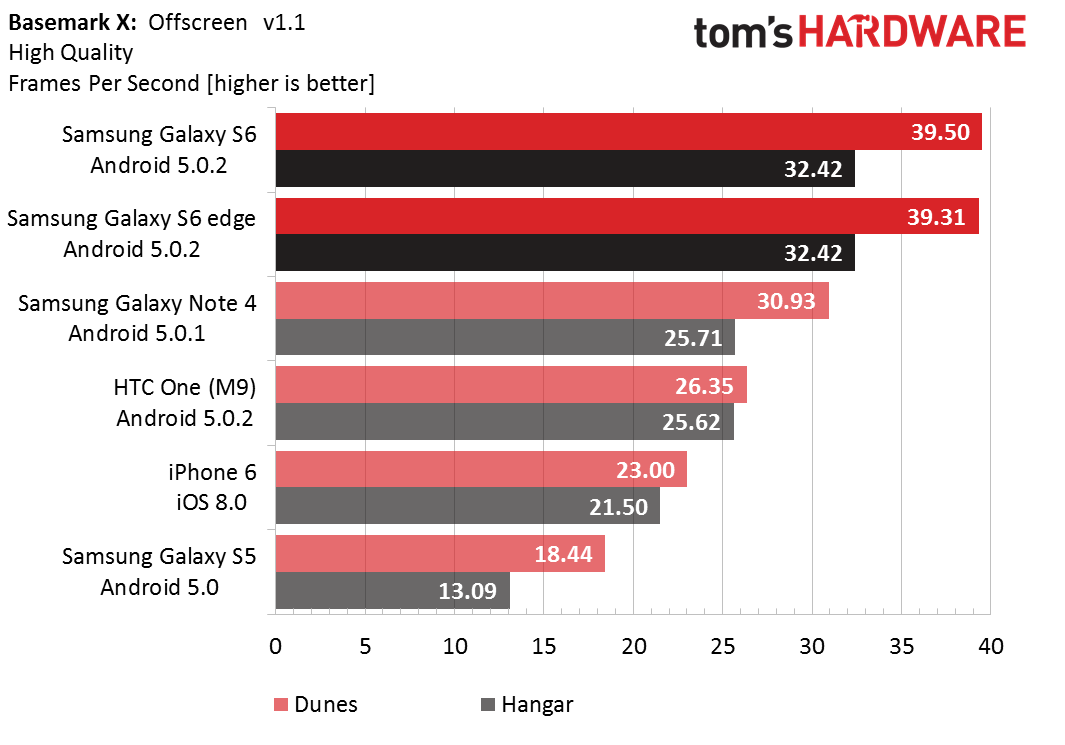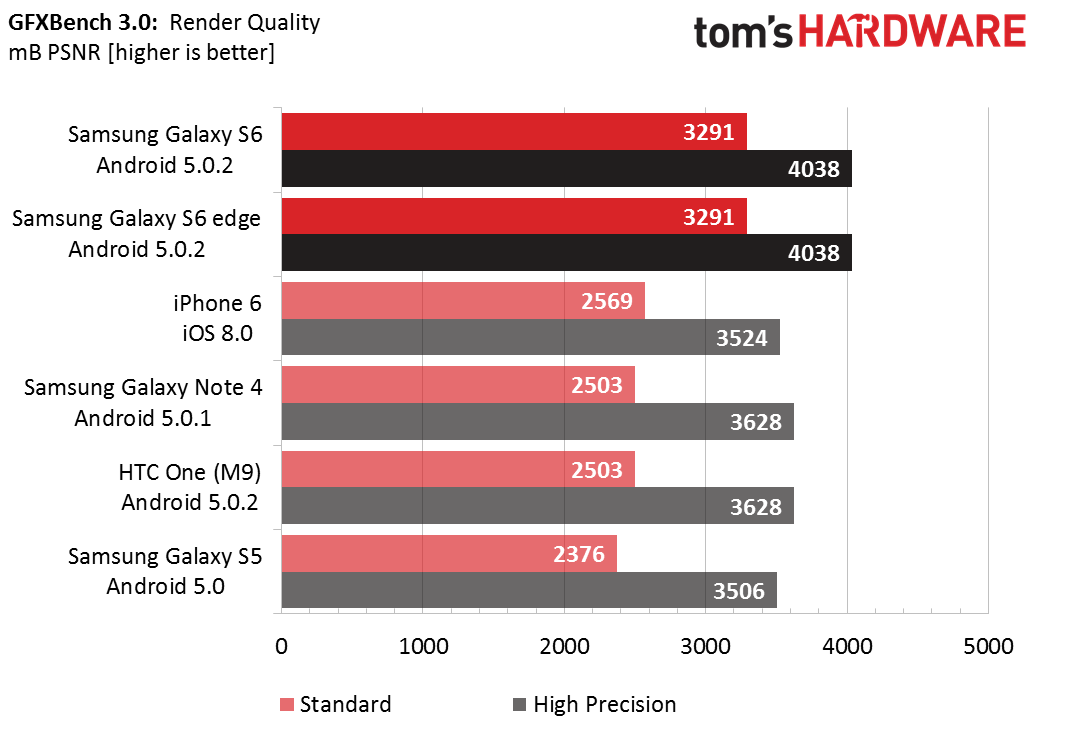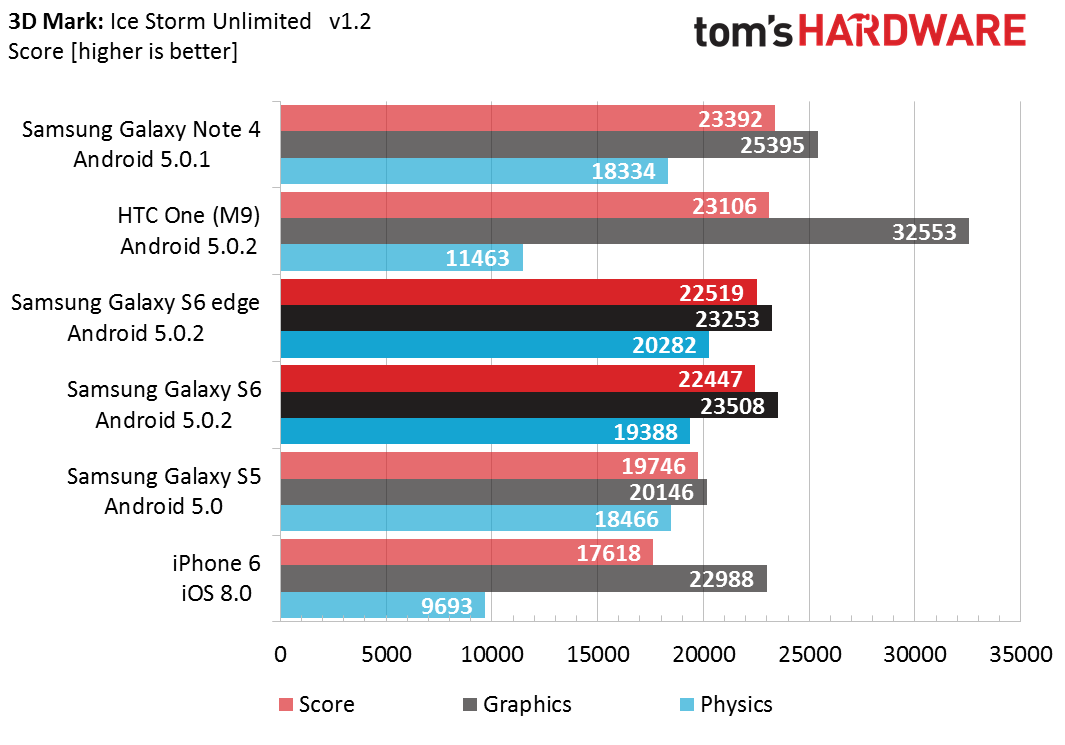Samsung Galaxy S6 And S6 Edge Review
The controversial new Samsung Galaxy S6 sheds its plastic construction, removable battery, expandable storage and environmental protection for slicker looks.
Why you can trust Tom's Hardware
GPU And Gaming Performance
Mobile GPU performance is becoming increasingly important as people begin to see their phones and tablets as portable gaming machines. This section explores GPU performance with several synthetic and real-world game engine tests. To learn more about how these benchmarks work, what versions we use, or our testing methodology, please read our article about how we test mobile device GPU performance.
The Galaxy S6 improves upon the S5’s graphics score by about 15%, but trails the other Adreno GPUs in 3DMark. When it comes to vertex processing, the Mali-T760MP8 GPU in the S6 matches the Galaxy Notes 4’s Adreno 420, but is 24% slower than the Adreno 430 in the HTC One (M9). In the second graphics test, which focuses on pixel processing, the Adreno 420 is 17% faster than the Mali in the S6, and the Adreno 430 is 44% faster.
The Physics test focuses on CPU performance, so it’s no surprise to see the S6 lead the pack. Similar to the AndEBench memory latency test, the 3DMark Physics test uses a data structure that requires random memory accesses, which the Snapdragon 810 in the HTC One (M9) seems to struggle with, further suggesting that the 810’s memory controller is optimized for sequential accesses like the A8 in the iPhone 6.



The Mali-T760MP8 performs well in Basemark X, topping the performance chart at the medium quality setting. When rendering offscreen, the S6 shows a 67% improvement over the S5 in Dunes and 46% in Hangar, even though it never pushes the Mali GPU past 700MHz.
Despite having to render almost twice as many pixels, the Galaxy S6 still manages to outpace both the S5 and M9 in the onscreen test.



Changing the quality setting to high produces similar results. The S6 uses its superior memory bandwidth to extend its lead over the previous generation S5 to more than 2x in Dunes and 2.5x in Hangar. To handle these more challenging tests, the S6 pushes GPU frequency up to the maximum of 772MHz.
We saw in 3DMark that the Mali-T760MP8 performs better, relative to the Adreno GPUs, in the first graphics test, which emphasizes vertex processing. Basemark X can use up to five times as many triangles as 3DMark: Ice Storm Unlimited, which seems to play to its strengths.
Get Tom's Hardware's best news and in-depth reviews, straight to your inbox.


While the Adreno 420 and 430 perform well in the GFXBench synthetic tests, this advantage does not extend to the shader heavy OpenGL ES 3.0 based Manhattan. The S6 edge, which holds a slim lead over the regular S6, outperforms the M9 by 20% and the Note 4 by 41% when rendering offscreen at 1080p. It’s also more than twice as fast as the Adreno 330 in the S5 and maintains an advantage even when rendering at a higher onscreen resolution.


T-Rex results look similar to Manhattan, with the curved-screen S6 having an edge over the regular S6 and extending its lead over the M9 and Note 4.









Something seems to be amiss in the Alpha Blending test. We should see performance remain about the same or decrease when rendering onscreen versus offscreen. This is indeed the case for all of the phones except the S6 and S6 edge, which actually perform significantly better in the onscreen test. Since we do not see this behavior in any of the other benchmarks, this is likely caused by a driver quirk or in how the test is coded.
Adreno wears the crown in the ALU test, where even the Adreno 330 in the S5 outperforms the S6. While we know next to nothing about the Adreno architecture, we do know that the Mali-T760MP8 can process 160 FP32 FLOPs/clock. The PowerVR GX6450 in the iPhone 6 can process 256 FP32 FLOPs/clock, but because of the S6’s higher GPU frequency, it should have the advantage in ALU performance, which it does. The results in this test reflect Qualcomm’s focus on improving ALU performance over the past few generations, and it certainly appears like the Adreno 430 has more ALUs than the Mali-T760MP8.
The S6 sees a 26% improvement over the S5 in the Fill test. Both the Mali-T760MP8 and the PowerVR GX6450 can process eight texels per clock, but due to the difference in GPU frequency (700MHz for the S6 and ~450MHz for the iPhone 6), the S6 should have a 56% advantage, which happens to be very close to the 52% difference we measured.
For the Adreno 420 in the Note 4, Qualcomm increased the size of the texture cache and optimized the ROPs. Based on performance results, it does not seem any further changes were made to cache sizes or the later stages for the Adreno 430. Still, the improvements introduced in the 420 give the latest Adreno GPUs an advantage over the Mali in the S6 in the Fill test. With up to a 50% lead in offscreen performance, the Adreno 420/430 likely have more ROPs than the Mali-T760MP8 too.
The Galaxy S6 sees a significant upgrade in GPU performance over the S5, even when rendering at its higher onscreen resolution. With a max frequency of 772MHz, the Mali GPU in the S6 also outperforms the PowerVR GPU in the iPhone 6. The comparison between the S6, Note 4, and M9 is less clear, however. Both the Adreno 420 and 430 offer better synthetic performance in GFXBench, but trail the S6 in the Manhattan, T-Rex, and Basemark X game engine tests. Regardless of who’s faster for a given scenario, the Galaxy S6 has the performance to fuel a premium gaming experience.
Current page: GPU And Gaming Performance
Prev Page CPU And System Performance Next Page Battery Life And Thermal Throttling-
LordConrad Considering that Samsung's AMOLED screens have 30% fewer subpixels than other screen types, the 33% pixel increase in the S6 should make it roughly equal to the 1080p screens from other manufacturers.Reply
I'm tired of Samsung trying to claim a higher pixel count when they don't even use the same pixel structure as everyone else. -
blackmagnum If Samsung doesn't release the latest Galaxy product, what benchmark would Apple compare its new iPhone with then? ...can't be LG, Motorola or HTC.Reply -
zodiacfml Battery testing and results doesn't seem to give useful information. There should be a test for Wi-Fi and LTE testing just to keep it close real world usage.Reply
Unfortunately for 3D gaming, the S6 should remain plugged in. This reminds me of the also slim Nexus 5 with good performance in all corners but kills the battery too fast for use as portable gaming device. I guess that's where affordable external battery banks come in. -
Reaver192 I cannot figure out which camera is in my phone???? I did a search or the file“/sys/devices/virtual/camera/rear/rear_camtype” and got no results in the file manager app I downloaded. I have a verizon s6(non-edge) I don't know why I even care but I really want to know for some reason which sensor is in my phone????? Any advice/ : )Reply -
darkchazz ReplyConsidering that Samsung's AMOLED screens have 30% fewer subpixels than other screen types, the 33% pixel increase in the S6 should make it roughly equal to the 1080p screens from other manufacturers.
Exactly!
I'm tired of Samsung trying to claim a higher pixel count when they don't even use the same pixel structure as everyone else.
This reminds me of the nexus 6.
moto/google market its display as an incredibly sharp 1440p AMOLED panel, when in reality its total number of pixels is less than that of the nexus 5's 1080p LCD. -
alex davies ReplyI cannot figure out which camera is in my phone???? I did a search or the file“/sys/devices/virtual/camera/rear/rear_camtype” and got no results in the file manager app I downloaded. I have a verizon s6(non-edge) I don't know why I even care but I really want to know for some reason which sensor is in my phone????? Any advice/ : )
I just tried an alternate method on the Canadian S6 I have. Dial *#34971539# and in the menu that comes up hit the 'ISP VER CHECK' option and pop-up should come up with the sensor info. I am not sure if this works for the Verizon S6. -
MobileEditor <quote>I cannot figure out which camera is in my phone???? I did a search or the file“/sys/devices/virtual/camera/rear/rear_camtype” and got no results in the file manager app I downloaded.</quote>Reply
You can try the method Alex pointed out if you are still using the 5.0.2 firmware. This has been removed in the 5.1.1 update (at least for T-Mo). Some file manager apps may not let you see the root filesystem. You can try ES File Explorer as an alternative.
- Matt Humrick, Mobile Editor, Tom's Hardware -
MobileEditor ReplyI just got a Verizon Galaxy S6 a few days ago. So far the battery life has been so poor that I'm considering switching to something else. From what I've been reading, it appears that the S6 has issues with how much power it is trying to drive to the wireless connections at a given time, causing excess battery drain even with the screen off.
Matt, did you experience any unusual battery behavior during your testing?
I did not experience excessive power drain related to wireless activity, but I'm on a different network (T-Mo), in a different area, with a different usage pattern, and even a different baseband. So my experience won't mean much for you.
I did read an article (forget where) showing that the Samsung RF components used more power than the Qualcomm equivalents. Since the Verizon model uses the Qualcomm components, I'm surprised you're seeing excessive power use. Did you switch carriers when you got the S6?
This could be a software configuration issue. How many different apps do you have that get/receive info from the Internet? How aggressively are they fetching data? Setting email, facebook, twitter, etc. to fetch data every 30s, for example, would keep your radios powered up and drain the battery more quickly. Look at the following:
1) Settings->Data usage to see which apps are consuming the most data
2) Settings->Battery->Battery Usage to see what's using the most power
3) Settings->Battery->Detail to manage which apps are running and to check the "Abnormal Battery Usage" tab.
You might try disabling messaging/social media apps or at least dialing back the fetch policy to at least 30mins for each as a test.
- Matt Humrick, Mobile Editor, Tom's Hardware -
cknobman TouchWiz still a memory hogging piece of trash.Reply
And Samsung wonders why they keep losing market share, idiots. -
Vlad Rose Dumbest move they did was remove the microSD card expansion. At least their Note has it still. Once they remove it from the Note line as well, it will be the last Samsung I own. It was the biggest reason why I chose them over getting the same thing as my wife's iPhone. I gave up FaceTime so that I could have music for work (and use skype instead).Reply


